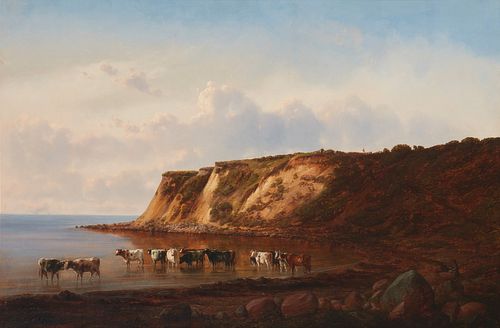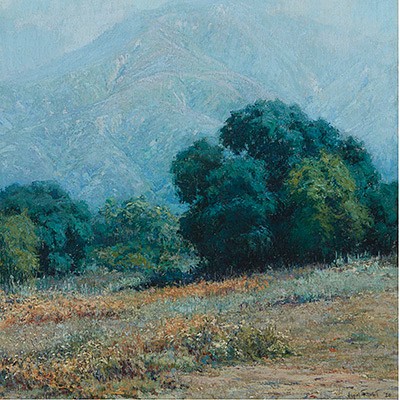Ferdinand Richardt (1819-1895, Oakland, CA)
About Seller
145 East Walnut Avenue
Monrovia, CA 91016
United States
John Moran Auctioneers is a family-owned and operated company, and market leader and trendsetter in sales of California and American art. We offer more works of California Impressionism, California Style watercolors, and Western art than any other auction house. Our personalized approach is our trad...Read more
Two ways to bid:
- Leave a max absentee bid and the platform will bid on your behalf up to your maximum bid during the live auction.
- Bid live during the auction and your bids will be submitted real-time to the auctioneer.
Bid Increments
| Price | Bid Increment |
|---|---|
| $0 | $25 |
| $500 | $50 |
| $1,000 | $100 |
| $2,000 | $250 |
| $5,000 | $500 |
| $10,000 | $1,000 |
| $20,000 | $2,500 |
| $50,000 | $5,000 |
| $100,000 | $10,000 |
| $200,000 | $25,000 |
| $500,000 | $50,000 |
| $1,000,000 | $100,000 |
About Auction
May 10, 2022
Los Angeles’ premiere auction house offers a sale of American, California, and Western fine art. Featuring paintings, sculptures, and prints by important 20th and 21st Century artists. John Moran Auctioneers info@johnmoran.com
- Lot Description
Cattle at Fort Scott (The Presidio), San Francisco, CA, c.1870
Oil on canvas laid to canvas
Signed lower right: F. Richardt
37.25" H x 55.5" W
Notes: In 1873, Ferdinand Richardt immigrated from Denmark to San Francisco. Prior to his transatlantic relocation with his family, Richardt was a renown painter to European royalty, including the King of Denmark and the Queen of England. In the 1850s, Richardt made several visits to the United States to fulfill commissions for venerable patrons such as William Vanderbilt. This particular assignment, painting the grandeur of Niagra Falls, proved to be a lucrative and high-profile artistic challenge. The endeavor ultimately afforded the artist the opportunity to work in the United States for an additional four years, during which time he readily established the reputation as a sought-after landscape painter.
The present work, painted during the artist's San Francisco period, is of noted historical significance. Richardt depicts a herd of cows watering in a shallow beach overseen by a cattleman and his dog. On the horizon, steam and sail ships make their way in and out of San Francisco Bay. Live oaks and scattered blooms of lupine punctuate the cliffside and suggest a spring afternoon on the coast. At first glance, this oil appears to feature the quintessential elements of a California pastoral landscape so often painted by Richardt's Bay Area contemporaries, such as William Keith, Charles Dorman Robinson and Raymond Dabb Yelland. Yet upon closer inspection, the viewer cannot fail to notice the inclusion of a silhouetted figure on the bluff: the watchful eye of a soldier on the ridge. This subtle detail is a reference to the value and importance of the herd of cattle, as well as an invitation to imagine what might lie beyond the ridgeline.
Richardt captures daily life at Fort Point's (aka Fort Scott) on the west side of the Presidio. Due to its proximity to the Golden Gate, in the decades after the Civil War, the strategic significance of the Fort increased. While Richardt was painting this canvas, the Fort was a beehive of activity and new construction. Naturally, the battalions stationed there, in addition to hundreds of construction workers living nearby, required a vast supply of food including meat, baked goods and other necessities to fuel their daily activities. Richardt sensitively depicts details of the trade activities that sustained this bustling, strategic fort.Visual: Generally good condition. Fine craquelure scattered throughout. Paint shrinkage in some of the white pigments of the clouds. A small spot of paint loss in the center.Condition
Blacklight: Small spots and lines of touch-up throughout, concentrated mainly in the sky, the largest a 1"x 2" scattered area lower center.
Frame: 45" H x 63.5" W x 3" D
- Shipping Info
-
Shipping: Buyers are responsible for arranging their own shipping estimates and deliveries. Moran’s in our discretion and as a courtesy to buyers, may arrange to have certain purchased lots packed, insured and forwarded by a third-party shipper at the request, expense and risk of the buyer. Moran’s assumes no responsibility for acts or omissions in such packing or shipping by other packers or carriers, even if recommended by Moran’s. Nor does Moran’s assume any responsibility for any damage to picture frames or to the glass therein. In circumstances where Moran’s arranges for such third-party services, Moran’s may apply an administration charge of 15% of that service fee.
-
- Buyer's Premium



 EUR
EUR CAD
CAD AUD
AUD GBP
GBP MXN
MXN HKD
HKD CNY
CNY MYR
MYR SEK
SEK SGD
SGD CHF
CHF THB
THB
















